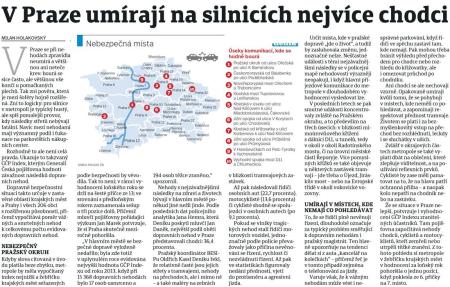Our members are dedicated to improving road safety and sharing their knowledge with the wider community. Here, you can explore our members' good practices – initiatives that have been assessed for their effectiveness in addressing a road safety problem and have proven results.
Get inspired – and sign up to share your good practices too!

Monday, May 22, 2023
The long-term project aims to improve road safety in urban areas across the Czech Republic. It focuses on assessing the severity of traffic accidents, with an emphasis on vulnerable road users. The target audience primarily includes the general public, local government representatives, regional authorities, and the Ministry of Transport

Monday, May 22, 2023
El principal objetivo del programa es promover la seguridad vial a través de la concienciación sobre la importancia de la abstinencia total de alcohol al volante, en lugar de simplemente cumplir con el límite legal permitido. El mensaje clave del programa es contundente: "Al volante, ni una gota de alcohol".
Con esta premisa, el programa busca fomentar la implementación en España de la figura del conductor alternativo, una persona que se compromete a no consumir alcohol para poder asumir la responsabilidad de conducir de manera segura. Esta figura ofrece una opción confiable y efectiva para prevenir accidentes causados por la conducción bajo los efectos del alcohol.
Además, el programa también se centra en promover hábitos responsables entre los pasajeros. Se recuerda a aquellos que deciden beber alcohol y son mayores de edad la importancia de hacerlo de forma moderada y responsable, evitando poner en riesgo su seguridad y la de los demás.
Con esta premisa, el programa busca fomentar la implementación en España de la figura del conductor alternativo, una persona que se compromete a no consumir alcohol para poder asumir la responsabilidad de conducir de manera segura. Esta figura ofrece una opción confiable y efectiva para prevenir accidentes causados por la conducción bajo los efectos del alcohol.
Además, el programa también se centra en promover hábitos responsables entre los pasajeros. Se recuerda a aquellos que deciden beber alcohol y son mayores de edad la importancia de hacerlo de forma moderada y responsable, evitando poner en riesgo su seguridad y la de los demás.

Wednesday, May 17, 2023
El contenido referido a 4º de primaria intenta cumplir los objetivos de hacer al alumnado autónomo como peatón, capaz de aprender y poner en práctica las normas que le proporcionan seguridad vial. Por ello, el truco de magia, que vemos en el video, trata de fomentar la necesidad atender y respetar las instrucciones de adultos y policías que en definitiva, no quieren otra cosa que, cuando salgan a la calle, se muevan con seguridad y lleguen a casa sanos y enteros.

Wednesday, May 17, 2023
El Ayuntamiento de la Vall d'Uixó cuenta desde junio de 2021 con un parque nuevo de educación vial de acceso libre y gratuito durante todo el año que cuenta calzadas de un y dos carriles para la circulación, aceras y edificios simulados, rotondas y señales.
Vive en el parque de educación vial consiste en una actividad generada para hacer el parque más vivencial, donde no se trata sólo de circular por el parque sino de moverse tal como se haría en una ciudad, es decir con un objetivo, un destino, desde una casa, con la necesidad de realizar paradas, hacer incorporaciones, señalizar, convirtiendo mágicamente la bicicleta en un peatón cuando las circunstancias lo permiten.
Vive en el parque de educación vial consiste en una actividad generada para hacer el parque más vivencial, donde no se trata sólo de circular por el parque sino de moverse tal como se haría en una ciudad, es decir con un objetivo, un destino, desde una casa, con la necesidad de realizar paradas, hacer incorporaciones, señalizar, convirtiendo mágicamente la bicicleta en un peatón cuando las circunstancias lo permiten.

Wednesday, May 17, 2023
Tras el levantamiento de las restricciones de la pandemia y, sobre todo en las semanas anteriores a la iniciativa, se habían incrementado los positivos de alcoholemia en los controles que la Policía Local realiza y tres siniestros habían contado con un positivo de la persona que conducía tras el verano. Por ello, se ha vio la necesidad de sensibilizar en la población para que no cogiera el coche si tenía la intención de beber alcohol, centrando la iniciativas en las cercanas fiestas navideñas donde las cenas familiares o de trabajo repuntan.